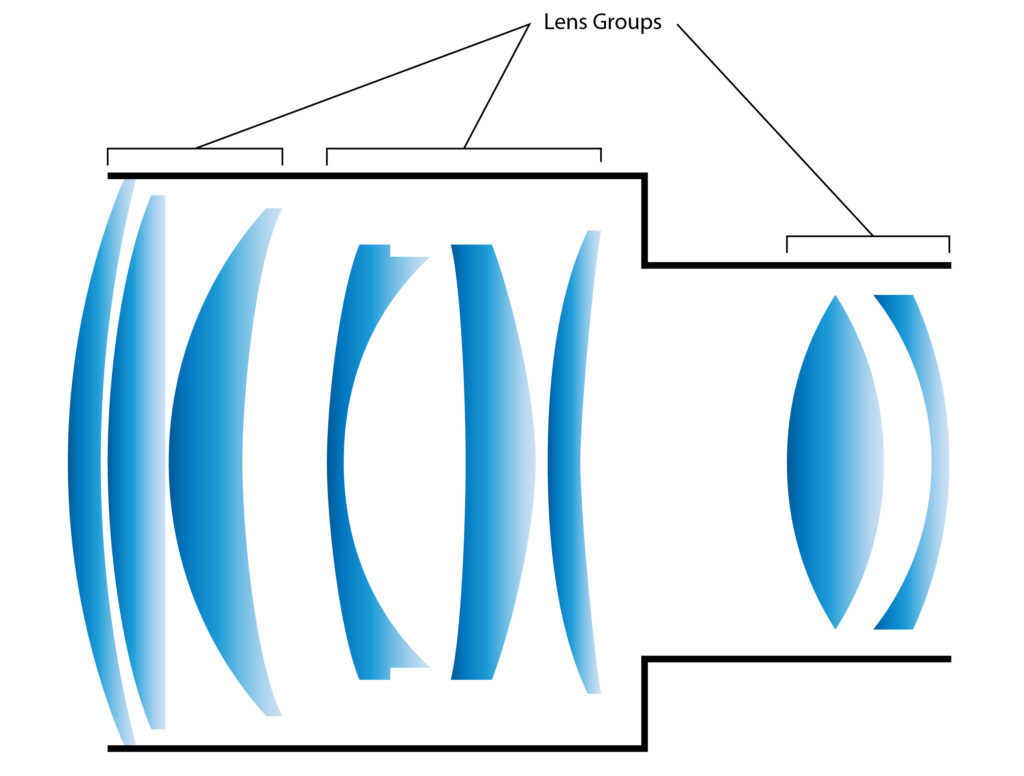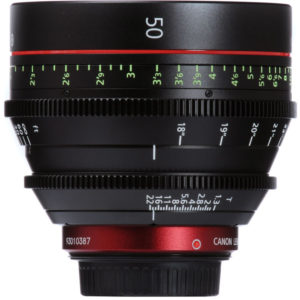What is the T-Stop?
The t-stop is a number that represents the absolute amount of light that reaches the sensor plane.
The Difference Between T-Stop and F-Stop
These two numbers are related, and understanding the difference requires a good understanding of the f-stop. I have written an entire article explaining the f-stop for your reference.
The f-stop is a physical parameter of the lens that is defined mathematically. This is not an arbitrary number. It is defined by the focal length of the lens and the diameter of the diaphragm. In theory, this tells us how much light passes through a lens and reaches the sensor plane. In practice, however, there will always be light lost in the lens. Therefore, there will be less light reaching the sensor than what the f-stop suggests.
Why is this the case, you might ask? Have a look at the image above and notice the reflections on the surface of the lens. Although this effect looks cool in a marketing document, it means that some of the light is being reflected off the surface of the lens and therefore not reaching the sensor. You can see the effect of this every time you look through a window. True, the person standing on the other side will see you through the window, but you will also see a faint reflection of yourself. This reflection of yourself is light that failed to pass through the window, therefore making yourself appear slightly darker to an observer on the other side. In addition, the glass will also absorb some of the light passing through it. So, there are two things happening here:
- Some of the light that reaches the surface of the glass is being reflected.
- Glass will always absorb some light. That absorbed light is neither reflected nor passed through.
Now we can see that not all the light that reaches the surface of the lens will pass all the way through and reach the sensor plane.
Lens manufacturers go to great lengths to minimize this effect. They coat the surface of the lens and use exotic materials in the glass itself to make the lens as transparent as possible. This happens to be one of the things you are paying for in an expensive camera lens.
Lenses are incredibly complex instruments. It turns out that zoom lenses are much more complex than prime (single focal length, or fixed) lenses. Figure 1 shows a very simplified diagram of the cross section of a typical lens:

Figure 1
The lens shown in Figure 1 has eight lens elements in three lens groups. To give you an example of a typical zoom lens, the very popular Canon EF 70-200mm f/2.8L USM II, has an amazing 23 lens elements in 19 groups! Compare that to a typical prime lens, the Canon EF 50mm f/.2L USM, which has eight lens elements in six groups. That is a lot of lenses to reflect and absorb light. This tells us that all other things being equal, a zoom lens will be darker than a prime lens even if the f-stop and focal length are set to the same values. And of course, keep in mind that the more extreme the range of a zoom lens, the more complex the lens will be. This means more lens elements and more loss of light.
I will point out the obvious, you get what you pay for. Lens coatings and exotic materials are expensive, so the more professional lenses will have much better performance than the less expensive consumer lenses.
This is where the t-stop (“T” for transmission) comes in. The t-stop is the corrected f-stop in terms of how much light actually reaches the sensor. Or stated in other words, the t-stop and the f-stop would be identical if the lens had 100% light transmission, which of course is not the case.
As a side note, cinematic lenses are labeled by their t-stop, while photographic lenses are labeled according to their f-stop. This can be seen in Figure 2 below, showing a Canon 50mm t/1.3 cinematic lens.

Figure 2
How Does the T-stop Affect Photography?
To answer this question, let’s look at some real-world numbers. I will be using data from DxOMark, which has performed an extensive amount of testing on just about every lens and camera on the market. Per their data, the Sigma 70-200mm f/2.8 EX DG APO OS HSM lens, mounted on a Nikon D810, has a t-stop of 3.0. That is the average t-stop across its entire zoom range, although the variation for this lens is very slight. When calculating the actual exposure, this lens will perform as though it were an f/3, even when the aperture is set to f/2.8. That represents a 13% loss of light, meaning that your image will be underexposed if you use a light meter to calculate the exposure and manually set the shutter speed, aperture, and ISO.
If you think that’s bad, let me assure you that the Sigma 70-200mm f/2.8 lens I used in the previous example is not the worst offender in its class. The Nikon 70-200mm f/2.8G ED VR II, also mounted on a Nikon D810, has a t-stop of 3.2. Even worse is the Canon 70-200mm f/2.8L IS II USM, mounted to a Canon 5D mark III, which has a t-stop of 3.4.
T-Stop and the Digital Sensor
This section gets into a bit more technical aspect of the t-stop, and can be skipped if you only shoot with film. This section also highlights another difference between shooting with digital versus film. Up to this point you may have noticed that I provided the t-stop of a lens while mated to a specific camera model. That is because there are two components to the t-stop:
- There is some loss of light within the lens itself, as described above. This is all you need to know if you are using a film camera.
- If you are using a digital camera, you will need to know that some light is lost within the digital sensor. This is depended upon both the camera and the lens being used.
The reason for light loss in a digital sensor has to do with the way in which a digital sensor is designed. The photo site (sometimes loosely referred to as a pixel) sits inside of a well as shown in Figure 3.

Figure 3
A typical digital sensor will have millions of photo sites arranged in a pattern. Each photo site is capped off by a lens element, below which lies a filter, followed by a photosensitive diode which converts the light energy into an electrical signal. By the laws of physics, there will be some light loss through the lens and filter elements in the photo site, as well as some diffraction due to the wave nature of light. This will be different for every digital sensor since no two sensors have the exact same parameters. One of the most influential parameters is the physical size of the photo site itself. All other things being equal, bigger is better when it comes to the size of a photo site. One of the major reasons for this is due to diffraction, which is inversely related to the size of the photo site. The smaller the photo site, the larger the diffraction. There is a lot of electronic processing that goes on in the camera to correct for these effects, and this is applied even to your raw files. Many people are surprised to discover that their RAW files are not as “raw” as they thought they were.
To give you another real-world example, I will provide you some more data, courtesy of DxOMark. I will use the Canon 70-200mm f/2.8L IS II USM lens as an example, mounted on various Canon bodies. The results are tabulated below in Table 1.
| Camera Model | 6D | 5D Mark III | 5DS R | 7D Mark II |
| T-Stop | 3.6 | 3.4 | 3.3 | 3.5 |
Table 1
As you can see, the t-stop varies considerably from one camera model to another, even with the same lens.
This begs the question: If there is so much loss of light, why are photographers not complaining about dark or underexposed images? Most photographers are unaware of the t-stop entirely, thinking that the f-stop is what determines how much light reaches the sensor plane. After all, that’s what every photographer was taught, right? The answer is a bit underhand. Remember how I told you that your images are heavily processed in camera (even RAW files)? As it turns out, the camera manufacturers apply a sneaky trick: they actually increase the ISO without you knowing it. For example, you might manually set your ISO to 200, and the camera will increase this by an amount necessary to compensate for the loss of light. This is the case even if you set your camera to auto ISO. The camera data may indicate an image was taken with a certain ISO, when in reality the applied ISO will be greater. As it turns out, the camera manufacturers do not disclose this information, but it has been measured empirically in the lab. This has frustrated some photographers, since we often select a manual ISO for a very good reason, or want to select the lowest possible ISO to maximize image quality, only to have the camera increase this by 10% or more. Sneaky, you might ask? Yes, of course it is, but that appears to be the way all camera manufacturers get around the problem.
Conclusion
Just remember this much: Not all light that reaches the surface of a lens will reach the sensor plane. There is simply no way around this as the laws of physics dictate that there will be some light lost. What this means is that you must work with two numbers, the f-stop and the t-stop. Use the f-stop when calculating depth-of-field, and the corrected f-stop, or t-stop, for calculating exposure. Again, zoom lenses will have more light loss than prime lenses, even when set to the same f-stop.
This is where things can get a little tricky though. When using any modern digital camera, whether it is professional or consumer grade will make no difference, you really don’t need to worry about the t-stop since the camera will automatically correct for this by increasing the ISO. This can be a little irritating to some, but that is just how the industry works. This might not be the case however with a few of the ultra-high-end technical cameras. In this case, you would need to take the t-stop into consideration. Since extensive testing such as that done by DxOMark is generally not performed on such cameras, you may have to do some testing yourself to make sure the exposure comes out correctly. Just keep that in mind.


